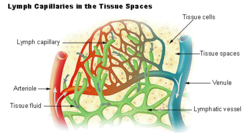
Back وعاء لمفي Arabic Limfni sud BS Vas limfàtic Catalan لوولەی لیمفی CKB Lymphgefäß German Λεμφαγγείο Greek Vaso linfático Spanish Lümfisooned Estonian Linfa-baso Basque رگ لنفی Persian
This article needs additional citations for verification. (April 2010) |
| Lymphatic vessel | |
|---|---|
 Lymph capillaries in the tissue spaces | |
 The thoracic duct and right lymphatic duct | |
| Details | |
| System | Lymphatic system |
| Identifiers | |
| Latin | vas lymphaticum |
| MeSH | D042601 |
| TA98 | A12.0.00.038 |
| TA2 | 3915 |
| TH | H3.09.02.0.05001 |
| FMA | 30315 |
| Anatomical terminology | |

The lymphatic vessels (or lymph vessels or lymphatics) are thin-walled vessels (tubes), structured like blood vessels, that carry lymph. As part of the lymphatic system, lymph vessels are complementary to the cardiovascular system. Lymph vessels are lined by endothelial cells, and have a thin layer of smooth muscle, and adventitia that binds the lymph vessels to the surrounding tissue. Lymph vessels are devoted to the propulsion of the lymph from the lymph capillaries, which are mainly concerned with the absorption of interstitial fluid from the tissues. Lymph capillaries are slightly bigger than their counterpart capillaries of the vascular system. Lymph vessels that carry lymph to a lymph node are called afferent lymph vessels, and those that carry it from a lymph node are called efferent lymph vessels, from where the lymph may travel to another lymph node, may be returned to a vein, or may travel to a larger lymph duct. Lymph ducts drain the lymph into one of the subclavian veins and thus return it to general circulation.
The vessels that bring lymph away from the tissues and towards the lymph nodes can be classified as afferent vessels. These afferent vessels then drain into the subcapsular sinus.[1] The efferent vessels that bring lymph from the lymphatic organs to the nodes bringing the lymph to the right lymphatic duct or the thoracic duct, the largest lymph vessel in the body. These vessels drain into the right and left subclavian veins, respectively. There are far more afferent vessels bringing in lymph than efferent vessels taking it out to allow for lymphocytes and macrophages to fulfill their immune support functions. The lymphatic vessels contain valves.
- ^ "19.2B: Distribution of Lymphatic Vessels". Medicine LibreTexts. 22 July 2018. Retrieved 28 November 2021.